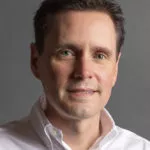“I SELL ICE in the winter, I sell fire in hell, I’m a hustler, baby, I’ll sell water to a well.” Jay-Z probably wasn’t thinking about today’s most overachieving dentists when he wrote that. OK, he definitely wasn’t thinking about dentists—but he could’ve been. These noteworthy doctors readily acknowledge the challenges dentistry is facing: rising tuition and student debt, increased competition, shrinking reimbursements and longer hours. But they don’t complain about it. Ever. To them, challenges are just part of the game.
One on One With the 40 Under 40
Call us nerds, but one of the events we look forward to most is our annual 40 Under 40 photo shoot in Manhattan. We get to spend two whole days with some of the brightest doctors from every corner of America—a little slice of editorial heaven for a team that geeks out on covering dental success and innovation.
Given that our 40 Under 40 honorees hardly have copious amounts of free time during a typical workday, catching up while they’re waiting around in hair and wardrobe is a once-a-year dream scenario when we can take their temperature on a range of issues affecting dentists and dental professionals everywhere. This year’s shoot was extra-special because it was our first in-person event since before the pandemic. Plus, with two years of pent-up curiosity burning a hole in our notepads, we had a lot of questions.
What you’ll find in our reporting is perspective on where young dentists’ heads are these days. It’s based on informal conversations (some over morning coffee, a few over evening cocktails) during the 40 Under 40 event, plus more interviews conducted via phone and email. It’s therefore a mix of on-the-record comments and casual chat that, taken together, we think reflects the mood, goals, concerns, challenges, insight and opportunities at the very top of the minds of America’s best young practitioners.
 THE EVOLVING DEFINITION OF RETIREMENTRETIREMENT
THE EVOLVING DEFINITION OF RETIREMENTRETIREMENT
Older doctors might cringe at the number of 40 Under 40 honorees who told us they plan to retire in their fifties—and, in some cases, their forties. Yet this reflects two new realities: one, the harsh physical demands of dentistry that are finally being recognized, and two, the many new opportunities to continue working as a professor, mentor or practice owner focused on entrepreneurship.
“Retirement to me just means pursuing another field of work that would allow for continued personal fulfillment and giving to my community,” says Seattle’s Dr. Trevor Kanack, whose target retirement age is a spry 45. Dr. Heather Ayers plans to spend more time teaching at West Virginia University, her alma mater: “I’m hoping to be able to decrease direct patient care hours somewhere around 55.” Most doctors, however, are planning to retire only from clinical dentistry so they can curb the wear and tear on their bodies and/or focus on building their practice full-time as CEO.
Some doctors are already living their post-clinical dreams. Since 2006, Dr. Ali Sadat has been growing his San Francisco startup, Retrace, which uses AI to turn around insurance claims more efficiently. “The team and I love what we’re doing,” he says, noting that he’ll keep working as long as he’s energized. Dr. Alex Vasserman, based in New York City, says that “to be honest, I have never really thought about retirement.” Meanwhile, Philadelphia’s Dr. Maria Cordero-Ricardo made a conscious choice about how best to balance the demands of her professional and family lives:
“I would rather work longer and enjoy raising my children now.”
 MORE TIME MANAGING, BUT MORE FULFILLMENTFULFILLMENT
MORE TIME MANAGING, BUT MORE FULFILLMENTFULFILLMENT
Many of this year’s 40 Under 40 told us they spend between one and two days each week on management tasks, but not consecutively. (One or two hours a day is the norm.) Some say that’s out of necessity to grapple with the increasing complexity of business ownership in general, while others intentionally devote management time to growing their practices. While it’s demanding, they generally consider it time well spent. “What gets measured gets improved,” notes Dr. Hoda Bassiri of Raleigh, North Carolina, who focuses on coaching and tracking her numbers.
“I find [administrative work] interesting and challenging,” says Pittsburgh-area pediatric dentist Dr. Priyanka Vaddi. “I wish I had more time to brainstorm new marketing strategies and be involved in more charitable initiatives.” Like many doctors we spoke with, she’s spending more hours working than when she started—“definitely more, but in a different way.”
Dr. Kelly Lewis, another Pittsburgh-area doctor, took the increasingly popular approach of partnering with her non-dentist husband to co-manage their pediatric practice. He has the MBA and a track record of success as an entrepreneur; as a result, she gets to focus more on delivering care. “Our approach is one of collaboration,” she tells us. “We consult with one another on important decisions, and his ability to manage the administrative aspects of the practice enables me to more efficiently and effectively serve our patients.”
What was once considered a necessary evil of practice ownership is actually the most exciting part for some entrepreneurs. Dr. Jazmin Floyd, a pediatric dentist in suburban Washington, D.C., is clear that she “would like to spend less time as a clinician and more time as
a business owner, mentoring associates and improving the patient experience.” Her goal? “To be the go-to practice of the community for all children’s needs.”
Like so many others, Dr. Nehi Ogbevoen of Newport Beach, California, is still overcoming a pandemic hangover. “Management, HR and business tasks are definitely time-consuming. Especially the past two years and interpreting the ever-changing Covid protocols as they pertained to our offices.” However, he also points to the growing complexity of treatment as a key reason he works more hours these days: “With digital orthodontics growing, there is more behind-the-scenes treatment planning that consumes a lot of time.”
SAYING NO TO (MOST) DSOs
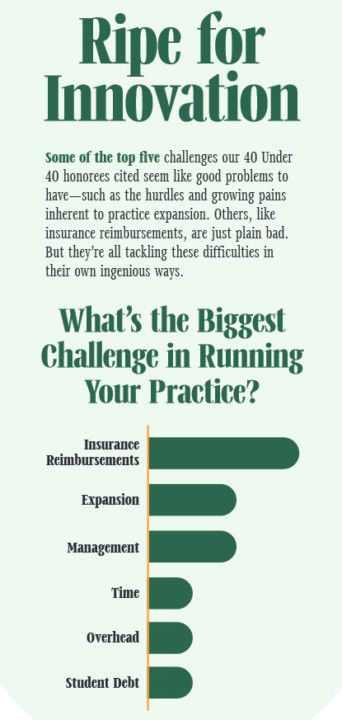
“NEVER,” writes Dr. Jarron Tawzer, in all caps for emphasis. Adds Dr. Bridget Sweeney: “Not likely. Been there, done that.” Dr. Megan Morrison slams the door shut as well, putting her chances of going with a DSO at “zero percent.” Others take a similar tack.
Why so adamant? Typical of the 40 Under 40’s highly ambitious and entrepreneurial nature, it appears that it’s not the DSO concept they dislike per se, but rather the execution. Amarillo, Texas–based Dr. Austin Whetten says he’s “more likely to create one than join one.” He raises a fair question: Why join ’em if you can beat ’em? Take Dr. Peter McClellan, for example. He and his partner’s offices in Kansas City, Missouri, are already structured as “a small-scale DSO that functions as a management team” for their six current locations, with two more on the way.
Others aren’t so much anti-DSO as, simply, pro-independence. Dr. Bassiri says she values “the family-oriented environment” that she and her husband created in their multidisciplinary practice, while Dr. Ogbevoen expresses his strong commitment to “being able to build my brand around my vision” as both a doctor and entrepreneur.
Dr. Daniel Leach, an oral surgeon in North Charleston, South Carolina, says his generation is pushing back against what he characterizes as
“DSO rhetoric” and has instead “gone old-school,” starting practices from scratch and making their own rules. “Every one of my colleagues—including myself—who have done just that are doing quite well.”
A few are noncommittal, if unenthusiastic, saying they might consider a DSO affiliation—if their circumstances changed. Dr. Matthew Doan, who practices in Carrollton, Texas, and is affiliated with a DSO, tells us the key to success is alignment with your own closely held values. “Find [a DSO] that offers mentorship, growth and work-life balance.” Richmond, Virginia’s Dr. Matthew Pelais, while admitting he’s personally unlikely to affiliate, points out that he has “seen some new emerging DSOs and changes to DSOs” that are in line with his way of thinking. “I believe dentistry should stay in the hands of the dentists. . . . I still feel that the best patient care is provided when a provider has a direct understanding of all sides of practice management,” he says.
LOOKING AHEAD FIVE YEARSFIVE YEARS
Nearly all the doctors we spoke with have a clear vision for where they’ll be in the foreseeable future—and exactly how they plan to get there. Dr. Whitney Weiner is building out a call center for her Detroit-area practices and centralizing services such as billing and ordering. “In three years, we’re on track to double revenue, add two new locations and five new doctors, and refinance our existing debt. We’re successfully scaling a legacy group dental practice.”
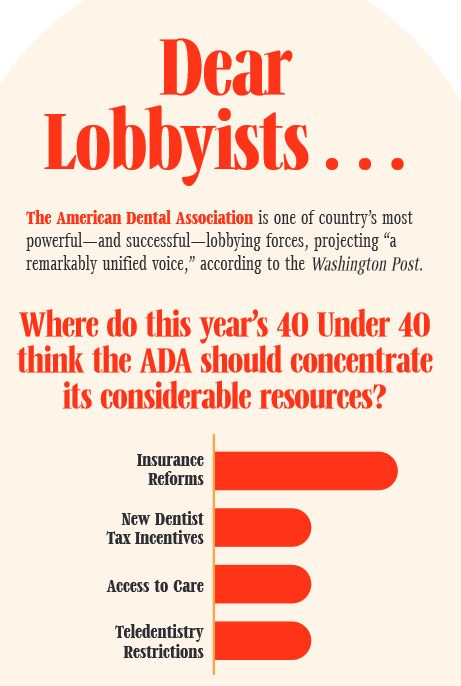
Bottom line: It’s full steam ahead for the talented, ambitious, unstoppable 40 Under 40 for 2022. What’s on their minds, more than anything else? Achieving their goals, their way, through a balance of clinical focus and entrepreneurial thinking that’s expanding the availability of care while simultaneously pushing the boundaries of dental medicine from coast to coast. It’s a great time to be a dentist—and an even better one to be among their patients.
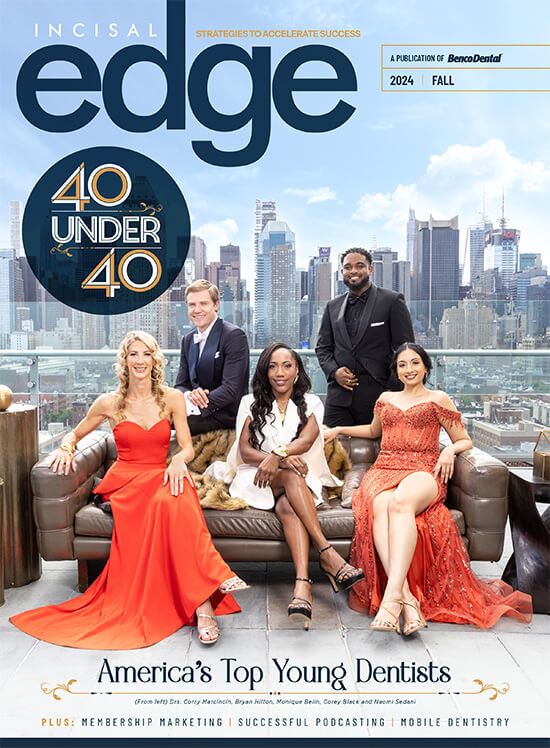


 THE EVOLVING DEFINITION OF RETIREMENTRETIREMENT
THE EVOLVING DEFINITION OF RETIREMENTRETIREMENT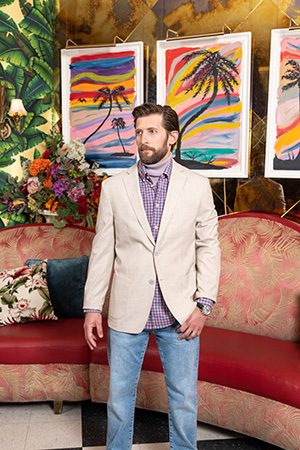 MORE TIME MANAGING, BUT MORE FULFILLMENTFULFILLMENT
MORE TIME MANAGING, BUT MORE FULFILLMENTFULFILLMENT
